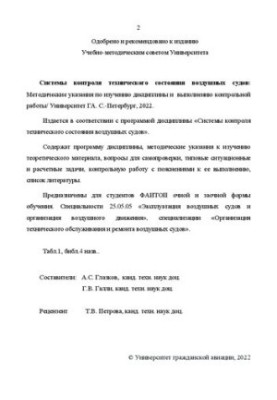Control systems of technical condition of aircraft: Methodical instructions for studying the discipline and performing control
 Instant download
Instant download
after payment (24/7)
 Wide range of formats
Wide range of formats
(for all gadgets)
 Full book
Full book
(including for Apple and Android)
Aircraft technical condition control systems : Guidelines for the study of the discipline and performance control”, prepared by the team of authors, is an indispensable guide for specialists and students seeking to better understand the mechanisms of ensuring the safety and reliability of aviation equipment . This book is a real guide to the world of modern systems for monitoring the technical condition of aircraft, combining the theoretical foundations and practical recommendations that are necessary for successful development and application in professional activities. The focus of this work is a set of methods and technologies that allow to identify and eliminate possible malfunctions in a timely manner, thereby ensuring flight safety and the durability of aviation equipment. The authors, who have extensive experience in the field of aviation engineering and maintenance, share their knowledge on the organization of control systems, diagnosis and prevention of malfunctions, as well as on the implementation of control procedures in accordance with modern standards and regulations. The book reveals the features of the monitoring and diagnostics systems, as well as considers the automation of control processes, which makes it relevant for specialists implementing innovative solutions in the aviation sector. This book will be a valuable tool for engineers, technicians, students of specialized universities and anyone interested in improving the safety and efficiency of aircraft operation. It is suitable for both beginners and experienced professionals who want to update their knowledge or systematize the acquired skills. Particular attention is paid to practical aspects - methods of performing control procedures, data analysis and decision-making based on the information received, which makes the book not only a theoretical manual, but also a practical guide. The topics raised in the “Aircraft Technical Condition Control Systems” cover a wide range of issues, ranging from the principles of operation of diagnostic and monitoring systems to methods for assessing technical condition and planning preventive measures. The authors analyze in detail modern standards and regulatory requirements, which is especially important for those who work in conditions of strict compliance with safety regulations and certification. The book highlights the importance of introducing innovative technologies such as automated diagnostic systems and artificial intelligence, making it relevant for those seeking to stay up to date with the latest trends in the aviation industry. The presentation style is distinguished by clarity and logical consistency, which makes it easy to assimilate complex technical concepts even for those who are just starting their way in aviation engineering. The author’s team, known for its publications in the field of aviation safety and maintenance, created a book that is not only informative, but also inspires the development of professional skills. Inspired by their other work, such as the Aircraft Maintenance Manuals and regulatory documents, it can be said that "Aircraft Maintenance Control Systems" is not just a training manual, but an important contribution to improving aviation safety. If you are looking for a book that will help you understand how modern monitoring and diagnostic systems ensure flight safety, or want to master the skills of conducting control activities, this work will become an indispensable assistant for you. In a world where safety and reliability are paramount, “Aircraft Maintenance Control Systems” open up new horizons of knowledge and professional growth. It deserves the attention of everyone who values quality and safety in aviation, and will become a reliable companion in your professional career.
LF/292280749/R
Data sheet
- Name of the Author
- Collective of authors
- Language
- Russian
- Release date
- 2022













